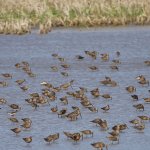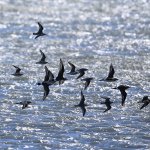Laguna de Rocha is a coastal saline lagoon that is intermittently joined with the Atlantic Ocean. Located in Uruguay, just five kilometers from the City of Rocha, it has been declared as Site of Regional Importance within the Western Hemisphere Shorebird Reserve Network (WHSRN). Currently the site is nationally recognized for its importance for the conservation of grassland shorebirds, as well as for showcasing a successful collaboration between the agricultural sector and conservationists. However, things were not always like this.
One of the first publications about the birds of Laguna de Rocha was written in 1996 by Juan Carlos Rudolf for the Conservation and Sustainable Development of East Wetlands Program (PROBIDES for its initials in Spanish). In this review of the birds recorded at this site, the presence of migratory shorebirds was noted, remarking on particularly significant concentrations of American Golden Plover (Pluvialis dominica), and White-rumped Sandpiper (Calidris fuscicollis) and the presence of Red Knot (C. canutus). The observations were based mainly in the area where the lagoon connects to the sea (Barra de Laguna), a public access zone where a sandy and muddy habitat predominates.
Other than these observations little else was known about the shorebirds in the area. The national and international scientific community, and the general public were unaware of the importance of this site, with the largest concentrations of shorebirds hidden in the grasslands at the edges of the lagoon. These grasslands are on private cattle ranches and not as accessible as the public area of Barra de Laguna. But the owners of neighboring lands were also unaware of the importance of the lagoon for shorebirds.
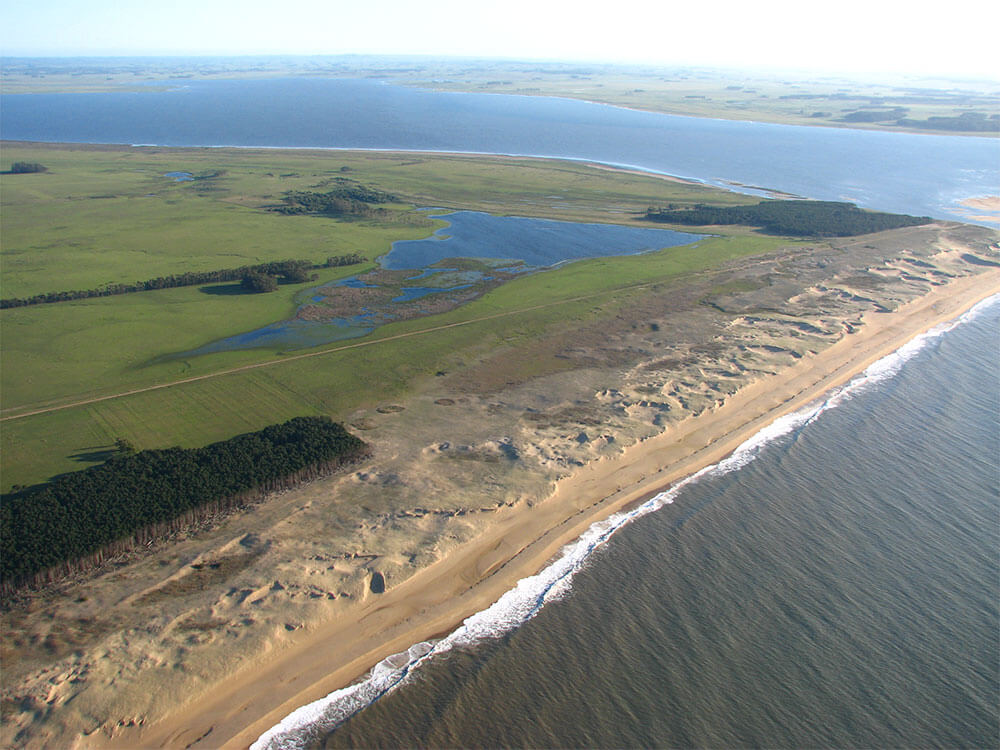
Grasslands at the Laguna de Rocha. Photo: Héctor Caymaris
In 2002, Richard Lanctot and his team began to document the value of the site with an unprecedented project that performed exhaustive searches in the grasslands of the River Plate Basin, an area including southern Brazil, Uruguay and Buenos Aires Province, Argentina. In this work, published in the Wilson Bulletin of Ornithology, Laguna de Rocha was highlighted as one of the most critical sites in the region for the Buff-breasted Sandpiper (C. subruficollis), and a link was made to the importance of cattle-grazing for the creation of the short grass habitat that the species requires. Despite this, the neighbors, the local government, the national environmental authorities, and even the owners of the crucial habitats, still remained largely unaware of the site as a sanctuary for shorebirds.
Daniel Blanco and his Wetlands International team, with the support of WHSRN, arrived at the site in 2006 with a project to study the relationship between cattle-ranching and the Buff-breasted Sandpiper. In parallel with this, the Grasslands Alliance (Alianza del Pastizal) took its first steps jointly with BirdLife International and its regional partners, with Aves Uruguay representing the country. This cooperative endeavor between institutions allowed an increased technical presence in the area, the initiation of studies in ecology and management, and the involvement of cattle-ranchers in the conservation of migratory shorebirds. Additionally, more emphasis was placed on diffusion of results and provision of information to the local community, and national and local authorities. As a direct result, with the agreement of landowners and national authorities, Laguna de Rocha was designated as the first WHSRN site in Uruguay in 2010. Reaching this milestone has allowed much more to be achieved, not least the recognition of the site as key to the conservation of Buff-breasted Sandpiper both by cattle-ranchers and the entire community. A few years later, during the development of a management plan for Laguna de Rocha (belonging to the National Protected Areas System or Sistema Nacional de Áreas Protegidas), grassland shorebirds were highlighted as the focal issue for conservation of the site.
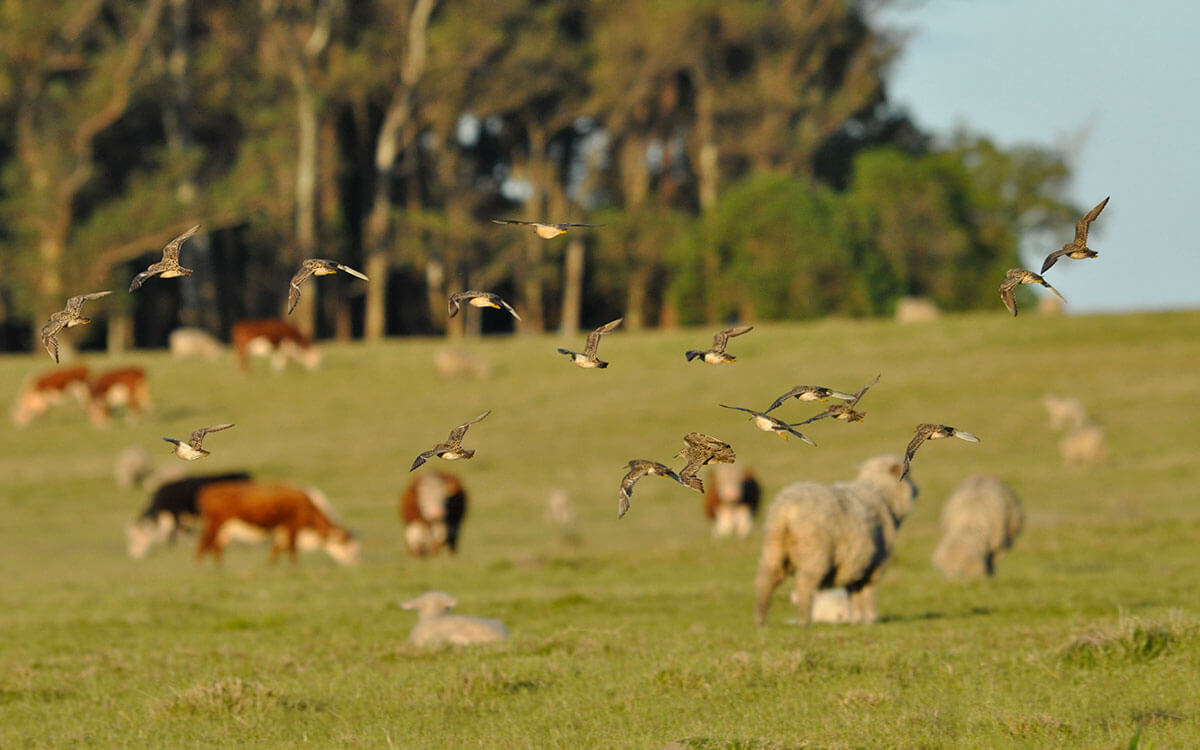
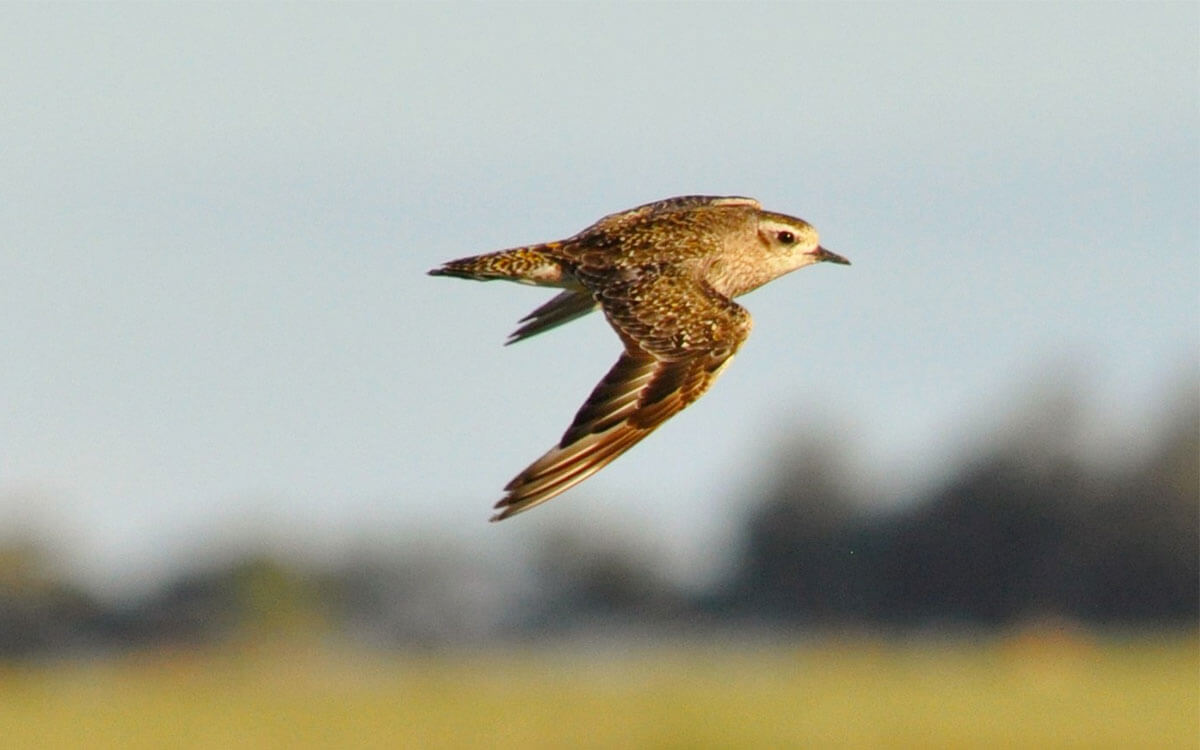
Left: a flock of Shorebirds on flight at the grasslands of Laguna de Rocha. Right: An American Golden Plover at Laguna de Rocha. Photos: Joaquín Aldabe.
Over these 15 years, many people have visited the lagoon, cooperating and supporting research. We have also received incredible local assistance and support in our work. One of the milestones was the visit of Joop Jukema, a Dutch expert in capturing, banding, and molt studies of plovers of the genus Pluvialis. Joop used an old, but extremely effective capture method, known as wilsternet. With a 82 feet (25 meters) long net, steel sling stands and a flock of rubber decoy plovers on the ground, Joop was able to catch large numbers of American Golden Plover.
Diverse studies were conducted at the lagoon, when I was working at Aves Uruguay and later on at CURE – Universidad de la República (University of the Republic). All provided unique and complementary data to support the development of the management plan. The work to complete these studies lead to unforgettable adventures, with friendships formed and life-long memories were created. There were long walks of tens of kilometers in the intense heat of the austral summer to perform counts. Entire nights were spent wandering grasslands to capture sleeping Buff-breasted Sandpipers to band them. With the support of many national and international institutions, we published an identification, conservation and management manual for the Laguna de Rocha shorebirds. This work allowed us to raise awareness about our species and bring shorebirds closer to producers and to the local and national community, as well as to strengthen park rangers and information managers capacities about this particular group of birds in the Laguna de Rocha.
Over the years the Laguna de Rocha grasslands, its shorebirds, and its cattle ranchers have taught us many things, and they will continue to do so. Maybe the most important lesson for agriculturalists, biologists, neighbors and institutions is that production and conservation are not mutually exclusive, in fact they can be complementary. In an agricultural region, this vision is important. Recently, one of the producers in the area made a significant and unprecedented contribution towards Fundación Lagunas Costeras (Coastal Lagoon Foundation) shorebird conservation project, which is financed by the Neotropical Migratory Bird Conservation Act (NMBCA). This reflects even more the synergy that can be achieved between these sectors. It is not by mistake that Laguna de Rocha is now nationally known as a successful demonstration of coexistence between humans and nature.
Cover Photo: American Golden Plover flock. Photo: Joaquín Aldabe.





